with their plastic baby Jesuses with candles
lit, from door to door looking for a place to be
taken in, and others will have their doors open for
them…anyone, really, to eat and drink
and share in their myth.

While you put the finishing touches on a lopsided snowman in your front yard, ice and snow artists around the world build life-sized ice castles, hotel rooms made of packed snow, and delicate ice sculptures stretching dozens of feet into the air. Illuminated at night, these amazing temporary structures built in some of the world’s coldest places each year look like something out of a winter fairy tale.


The only true ice hotel in North America, Hotel de Glace opens each January with a new theme. In early 2013, that theme was “A Journey to the Center of Winter,” inspired by the Jules Verne novel “Journey to the Center of the Earth.” It had 44 guest rooms as well as a spa, restaurant, chapel and a bar made of ice.

Incredible replicas of Renaissance architecture, classic Russian architecture and other impressive structures are recreated at China’s Jingyue Snow World Festival each year. While not quite life-sized, this ice and snow architecture often reaches heights of thirty to forty feet. They’re hand-carved using low-tech tools.


For just seven days each February, millions of visitors gaze upon intricately carved ice architecture and other large-scale sculptures for the Sapporo Snow Festival on the streets of Sapporo City. More than 10 teams compete in the International Snow Statue Contest to build structures reaching 50 feet tall and 150 feet wide, including life-sized dinosaurs. The largest structures can cost up to $100,000 to create, so they’re typically sponsored by countries or corporations.


Harbin, China transforms into an ethereal showcase of ice architecture and sculptures illuminated in bright colors each January. The annual festival began as a traditional ice lantern garden party in 1963 and is now the largest snow and ice festival in the world, taking over virtually the entire city, with a unique theme each year.

“Hail the machines, sweet old machines, blow off the dust, wipe off the rust. Christmas has come, joy is foretold, for those of us you never sold. Still we are here, still full of cheer, just plug us in, it will begin.” So starts the Christmas carol this quirky choir of vintage computer equipment would like to sing to you today courtesy of The Glasgow School of Art.

Alumnus James Houston, who graduated in 2008, created the project using a collection of vintage Mac computers, a Commodore 64, ZX Spectrum +1 and a SEGA Mega Drive. The lyrics to the song ‘Carol of the Bells’ were rewritten accordingly.

Houston got the idea when pondering new uses for past Christmas gifts, realizing that a few of them had the capability for speech synthesis.

“Bleep bloop beep bong, hear our sweet song, if none of our coding is wrong.”

This competition-winning design uses upcycled materials to frame a street-facing experience, in part through a fresh take on ‘window shopping’. Its aim: to create a unique and sustainable experience for Londoners looking to purchase fruit- or vegetable-producing plants.


Sponsored by Hackney City Farm, the competition encouraged applicants to reuse materials and strive for sustainability, but this group set themselves apart by proposing something both contextual and eye-catching with a strong pedestrian-side presence.


The team behind this colorfully-painted Sill-to-Sillsolution drew inspiration, as well as many of their actual materials, “from the architecture of the local neighbourhood, defined by streets of Victorian terrace houses with their imposing brick facades and generous sash windows. In recent years these homes have been bought up in a wave of gentrification and as new owners move, builders get to work, improvements are made and old materials are discarded.”


Alongside recycled slats used for the walls, these found window elements were turned into benches, counters, shelves, notice boards and sources of natural light, most prominently used as a colorful display that draws people in from the sidewalk to see their wares. “‘Sill to Sill’ aims to encourage local people to take up urban agriculture by presenting plants in an immediately familiar setting: ‘buy from our window sill and grow on your window sill’.”



Part of the approach also involved using strategies that would allow for easier construction despite apparent architectural complexity: “Though visually sophisticated, the design utilized basic timber construction techniques and simple materials in a manner that could easily be assembled by a team of unskilled volunteers. Community involvement at every stage of the project, from inception through construction and on to use, was at the core of the team’s proposal.”

Reimagined, repositioned and recomposed, this photo manipulation series turns familiar elements of buildings into abstracted compositions that morph beyond architecture, bridging disparate worlds of design and art.

Canadian photographer Cory Stevens starts with exteriors, ceilings, walls and windows, then adds his artistic twist – a variation on the polar panoramic approach.

While pattern recognition may persist in some cases, the rotation and multiplication in many of these pieces makes them increasingly abstract.

The symmetry of these fractal forms begin to make us see other patterns of nature, like snowflakes or star systems, in the shapes and materials of otherwise everyday towers, monuments, habitations, town squares and civic circles.


From the photographer:“Though my primary focus is on architecture and urban environments, I also like to indulge my love of the natural landscape. Digital abstracts have also become a growing segment of my work – inspired by my passion for design and the modern aesthetic.”
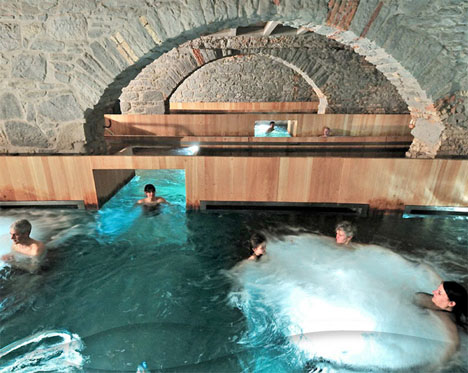
Lounge in large wooden vats that once contained gallons upon gallons of beer, gazing up at the original stone arches in subterranean vaulted chambers. The Hürlimann Brewery in Zurich, built in 1836, has been transformed into a hotel and thermal spa with naturally heated water from a nearby spring.
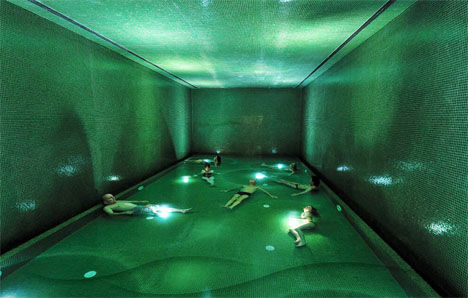
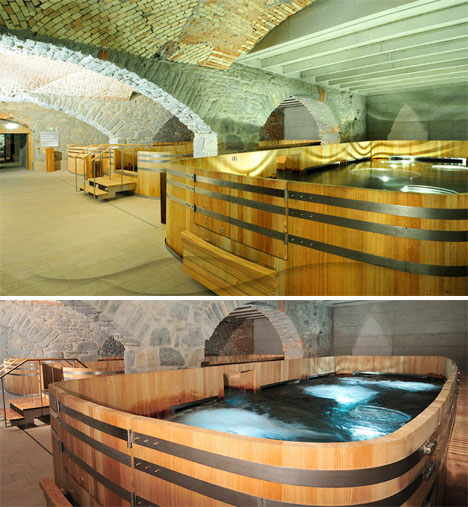
Guests don’t actually bathe in beer here (there are other places to do that) but they get to enjoy the next best thing in spacious hot tubs made from the reclaimed barrels. The clean lines of wood and steel in the new construction contrast with, yet complement the aged stone architecture of the original facility.
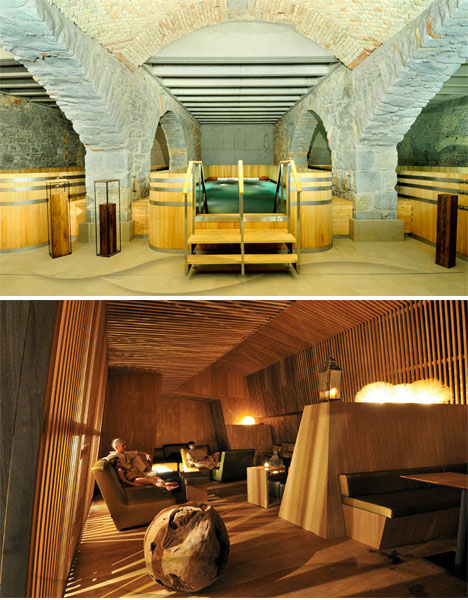
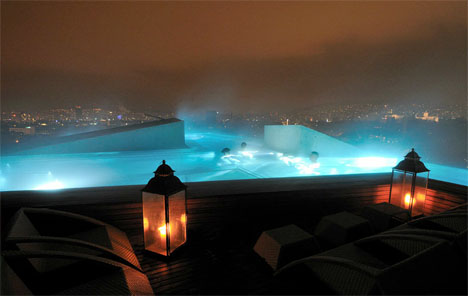

Enclosed tiled rooms offer large pools in which to lay on your back and float, and the places to soak extend all the way up to the hotel’s rooftop, with heated pools looking out onto the city of Zurich.
Diss Guy: DeJuan Blair, Gettin’ it Done with Class
There is something I enjoy about DeJuan Blair. Much of it has to do with his style of play; a burly, wrecking-ball-esque sort of affair that relies upon positioning, timing and strength to be effective, at least for short bursts. I’ve always identified with shorter, stockier players who could tussle with the bigger boys in the post, and in this regard, Blair is one of the best. But the bigger part has to do with his story; with what makes him different among his peers in the post. Of course, Blair has no ACLs in either of his knees; a frightening malady for a basketball player who needs to be able to absorb the shock of constant jumping-and-landing. This led to him slipping from the lottery all the way to the second round, where San Antonio snatched him up with the 37th overall pick in 2009. And, to date, it has not caused a single issue for him as a professional.
However, though Blair’s prolonged health throughout his career has been a cause of celebration, his time as a Spur was not always so cheerful. Despite the fact that Blair roared out of the gate as a rookie — he nearly averaged a double-double during the first part of his rookie season, drew comparisons to Charles Barkley, and was one of the more efficient players on the court when he logged time — he never fully caught on as a permanent fixture in Gregg Popovich’s rotation. He spent time doing just about everything in four seasons for the Spurs; starting as an undersized center alongside Tim Duncan, coming off the bench as a rugged scorer and rebounder, and sometimes even logging DNP’s as other players took the floor instead of him. He never became the long-term answer to the problem that has really befuddled the Spurs since David Robinson retired in 2003; that is, finding a player could start permanently alongside Tim Duncan. So, following the conclusion of the Spurs-Heat Finals last summer, and with Tiago Splitter getting the chance to become the Spurs center for the next several years, Blair had enough, and took his talents to Dallas on a one-year minimum contract. In his departure, Popovich was gracious to Blair, praising his professionalism in the wake of a playoff benching, and having next to no opportunity to play in the NBA finals. But in the lead-up to the first matchup between the Mavericks and the Spurs this season, Blair has let his frustration be known. “(Gregg Popovich) stopped (playing) me. I couldn’t tell you what was going through that man’s head at all. Nobody knows but him,” he is quoted in the Spurs Nation blog,“I didn’t think they believed in me in San Antonio, so that’s pretty good here. I feel supported.”
In spite of the strong but understandable words, it was nice to see Blair do his thing against his old team last night. He had 14 and 11 in a 116-107 loss to the Spurs; another strong campaign in what has become something of a comeback season for the forward-center. He went hard against both Splitter and Boris Diaw; the men who took his playing time, and made him expendable. And, after the game, he backed away from his strong words, and offered some warm assessments of his former coach and friends. “I told him I still love him, love the team,” Blair told Dwaine Price of the Dallas-Fort Worth Star-Telegram, adding that “they are all still my brothers off the court.” When asked whether the loss was especially frustrating because it was his former team, Blair was honest, yet gracious “They are a great team. It’s just something that they do.”
Indeed, it’s something that they do, and one might argue that Blair has wisely decided to throw Pop a few bones. Long a proponent of resting players — and, at this point, something of a symbol against David Stern’s preference for showcasing the walking wounded as long as a national television audience is watching — Pop has always placed his team’s health over wins. As we watch DeJuan succeed as a rotational big man in Dallas, one must wonder if Pop’s choice to keep him on the shelf while he was a Spur did not reap benefits for when he became a Maverick later on. He has looked spry and useful this season, and though he still displays the same defensive shortcomings that prompted Pop to turn to Splitter and Diaw instead to Blair, he is part of a winning cause in Dallas, and shows no signs of slowing down, due to his knees, DNPs, or anything else.
I’m happy DeJuan has found a home, and that realizes that he got a great early professional education in a wonderful place.
Miss Guy: Four Blowouts a-Suckin’

Though (as predicted) the Warriors/Clippers game was worth the wait, I had to sit through a lot of crap to get to it. Every single game leading up to the East Bay Bloodbath was garbage. Straight-up trash. Nets/Bulls was a snooze-fest. Thunder/Knicks was awful. Heat/Lakers at least gave us a good first half, but fell apart in the second. Rockets/Spurs had its moments, but the Rockets ended it in the fourth quarter. Luckily the Clippers and Warriors were able to save face for the entire league. Otherwise, every single casual fan who planned on starting their basketball-watching season would never watch any NBA ball for the rest of the season. Would you? The body language the entire day was awful. The players didn’t want to be playing. The coaches didn’t want to be coaching. The thing was produced with a slew of obnoxious gimmicks and money-grabs. And the boos that rang from the rafters as four home teams lost their Christmas Day games seemed oddly appropriate, given everything that occurred.
Now, I’m not a huge fan in explaining why losses occur — “it’s the basketball, stupid” — since I think it’s a meaningless pursuit in an enterprise (that is, sports-writing) that is honestly short on true meanings. But one has to wonder if there isn’t a deeper truth in a Christmas Day slate that produces four certifiable lemons, and one ultra testy game at the very end of the day. No matter what the salary is, no employee is happy about having to work on a public holiday, away from family and other loved ones. If they’re forced to go in to work on said public holiday, they certainly aren’t going to put their heart and soul into working, since obviously all that matters to the bosses, on that day, is money, money, money. At that point, it seems likely that the employee is going to go through the motions until they can go home and have some semblance of a break.
If the NBA shuttered its windows and barred its doors on Christmas Day — like most fair workplaces are supposed to — I don’t think I would mind. Because frankly, there could have been no games on Christmas, and it would’ve been better than the slop that was served to us. Four blowouts and a game where the players seem ready to rip each other to bits seems to be indicative of a larger emotion than just competitiveness; one that is fundamentally displeased about the way they are being used to push the larger product.
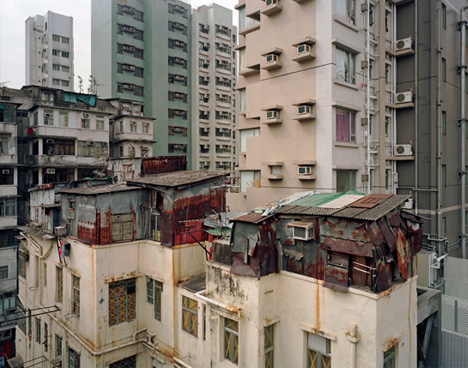
These hidden shanty towns, often invisible from the streets below, sprawl like surrealist suburbs across the roofs of one of the most densely-populated and expensive cities in the world.

The book Portraits From Above meticulously documents a series of such informal micro-villages in Hong Kong with photographs, detailed diagrams and stories of life inside these illicit rooftop communities.
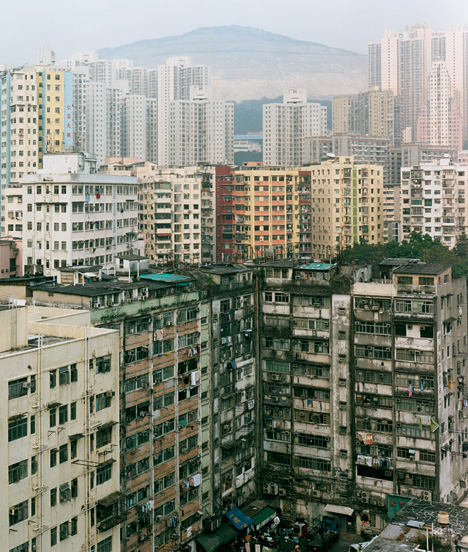
While the dwellings are unconventional in shape, the book’s drawings are almost deceptively refined, capturing the chaos in clean black-on-white architectural lines.

Ad hoc architecture at its strangest, these structures are not governed by building codes or compliance issues. Found materials from sheet metal and scrap wood to discarded plastic and broken brick shape home walls and the narrow halls between homes.
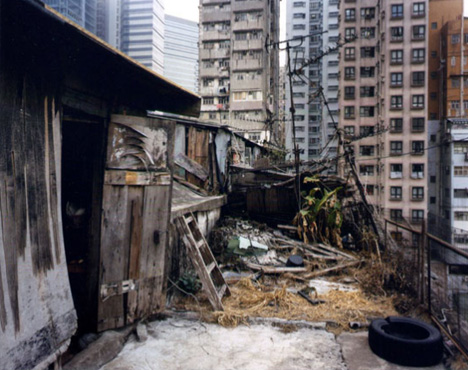
Naturally, one downside of such unplanned habitats are the series of power and waste management issues that go with the territory.
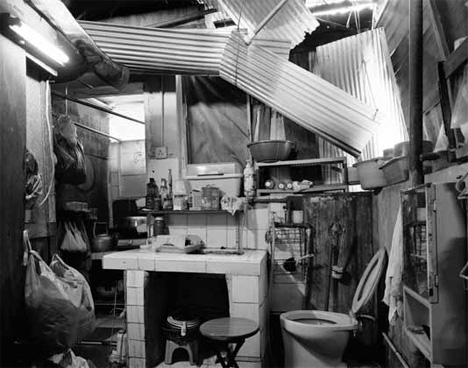
Despite living on the fringes – or perhaps because their shared connection – there are strong social ties between rooftop dwellers, and they were welcoming to the authors of this book, Stefan Canham and Rufina Wu, who sought to learn more about how people live in such offbeat accommodations. In many ways, too, these mini-cities are like smaller expressions of larger-scale phenomenon like the nearby but now-demolished Kowloon Walled City.

From the foreword: “There is no elevator. We run eight floors up the stairs … out of breath. The roof is a maze of corridors, narrow passageways between huts made of sheet metal, wood, brick and plastics. Steps and ladders leading up to a second level of huts. We get lost …. Rufina knocks on a door. A brief conversation in Cantonese. Stefan stands in the background, the foreigner, smiling, not understanding a word. They listen to us, smile and invite us into their homes. Later, we look from a high building on the other side of the street down at the building [we were on before]. The roof is huge, with thirty or forty households, like a village. From the outside it is impossible to guess what it looks like on the inside.”

Later, “We walk back up the stairs. We no longer get lost in the corridors. We learn how the residents rebuild their homes and keep [them] in good shape. There are people who live for twenty or thirty years on the roof[s]. The newcomers from China, Southeast Asia [and] Pakistan still do it …. Some underlying buildings slowly disintegrate, because the concrete was mixed with salt water. Most residents roof would not mind to live in one of the new high-rise buildings, but they can not afford it. All are afraid to be resettled in the satellite towns, where there are few prospects. The rooftop settlements are an urban legacy. They tell of the history of Hong Kong, the political upheavals in China, renovation, and demolition speculation, [structural] calculations and what people need to live in the city.”

Hundreds of orange-roofed Howard Johnson’s hotels, motels and restaurants once served fried clam strips and ice cream to tired, hungry American travelers.
 (images via: William Bird, Collisionbend and Cleveland.com)
(images via: William Bird, Collisionbend and Cleveland.com)
Howard Johnson’s Lakefront Motor Lodge opened in 1965, the historical heart of the company’s postwar golden age. Offering spectacular views of Lake Erie and easy access to downtown Cleveland, the 12-story highrise featured a Red Coach Grill restaurant and Cocktail Lounge (how Mad Men!). Clevelanders of a certain age will fondly recall enjoying Howard Johnson’s famous ice cream at the in-house restaurant… and will not-so-fondly recall the longstanding eyesore the building would become.
 (images via: The Plain Dealer/Marvin Fong and Peace On Earth)
(images via: The Plain Dealer/Marvin Fong and Peace On Earth)
When Howard Brennan Johnson (son of founder Howard Deering Johnson) sold his company in 1979, it set off a decade-long domino effect of ownership changes, none of which helped the chain recover its declining fortunes. Howard Johnson’s Lakefront Motor Lodge epitomized the corporate trainwreck: by 1986 the hotel had lost its Howard Johnson’s branding and stood as an abandoned eyesore until late 2009, when the wrecker’s ball was finally allowed to complete the building’s collapse.
 (image via: Tim Hill (timojhill))
(image via: Tim Hill (timojhill))
The I-95 corridor was made for travelers and where there are travelers, you’ll find a Howard Johnson’s… or what used to be one. This moldering abandonment waits silently for either the wrecking ball or a casual arsonist while defiantly wearing its mildewed orange roof as a callout to long past better days. Kudos to Flickr user Tim Hill (timojhill) for infusing just the right amount of subtle menace into the disturbingly distinct photo above. By the way, potential trespassers, the “pool” is closed and diving is NOT recommended.
 (images via: Debra Jane Seltzer (Roadsidenut) and Host of the Highways)
(images via: Debra Jane Seltzer (Roadsidenut) and Host of the Highways)
All dogs may go to heaven but only a few expired Howard Johnson’s make the leap, and the former HoJo’s restaurant off US-40 in Springfield, Ohio is one of them. Would it be flippant to suggest this venerable eatery has been reborn to serve a higher power? Does the collection plate exude the faint aroma of fried clams? Does the whole scenario smack of a yet-untold Simpsons story line? Hey, we’re in Springfield after all.
 (image via: Scottamus)
(image via: Scottamus)
Much like old Holiday Inn signs, Howard Johnson’s signs were the faces of the franchise and when a HoJo loses its mojo, the sign is either the last to go or the first remnant to be reused. A tip of the hat to Flickr user Scottamus for the er, heavenly photo from July of 2010 of the former HoJo’s main signage above.
 (images via: Host of the Highways and Scottamus)
(images via: Host of the Highways and Scottamus)
The Howard Johnson’s Motor Lodge and restaurant off I-75 in Dayton was built in 1959 and enjoyed the better part of a quarter-century as one of the Ohio city’s prime travel service destinations. All that came to an end in the mid-1980s when the Motor Lodge became first an Econo Lodge, then the unbranded Parkway Inn. The latter closed in 2005 following the shooting death of a patron in a drug deal gone bad. After sitting abandoned for several years, during which the former HoJo’s trademark orange roof threatened to shed its alien coat of dull blue paint, the complex was demolished in April of 2010.